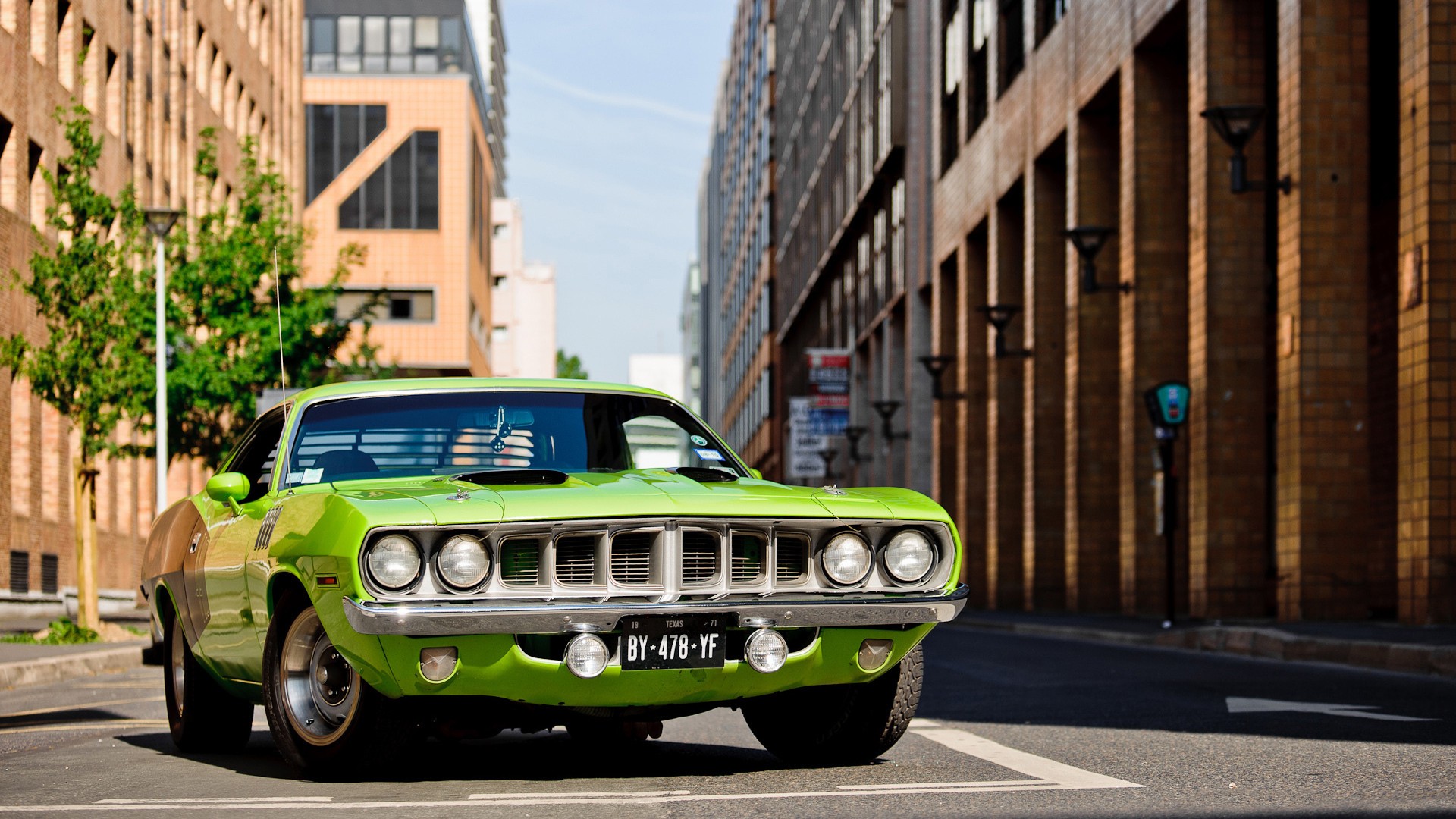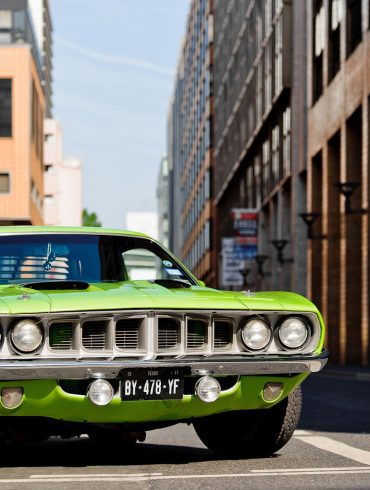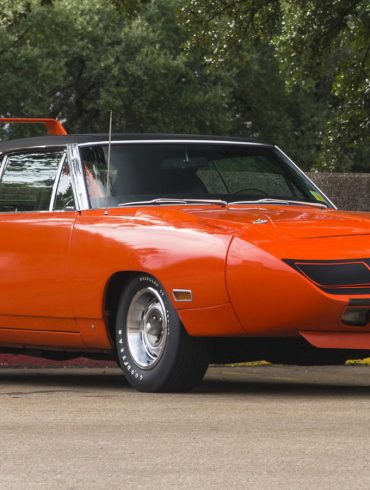Plymouth 0-60 & Quarter Mile Times
Plymouth Acceleration & Performance Data
Introducing Plymouth 0-60 mph and Quarter Mile times for all models. Below, we have painstakingly collected and organized all the Plymouth performance data we could get our hands on. Our data table and chart provides a comprehensive overview of each Plymouth model's performance capabilities.
Summary / Performance Table / Performance Chart / Fastest Cars Ever
This page aims to put all of the performance metrics of Plymouth's entire model range (both current and historic) in one place, providing enthusiasts and prospective buyers with valuable insights into each vehicle's acceleration capabilities. We know that 0-60 times don't tell us the full performance picture, but by reviewing 0-60 mph times at least you can get a benchmark for measuring a car's acceleration prowess, and the quarter mile times, which offer a glimpse into its straight-line speed, readers can gain a deeper understanding of Plymouth performance pedigree. Plymouth, a brand once known for its affordable and reliable cars, made a significant impact in the world of high-performance vehicles during the muscle car era. With a strong emphasis on power and speed, Plymouth produced some of the most iconic and fastest cars of its time. Here’s a look at some of the fastest Plymouth vehicles over the decades and the brand’s broader performance credentials.
Plymouth Road Runner (1968-1980): The Plymouth Road Runner was introduced in 1968 as a no-frills, high-performance muscle car that emphasized speed and power over luxury. The Road Runner’s most powerful engine option was the 426 HEMI V8, which produced 425 horsepower and 490 lb-ft of torque. This engine allowed the Road Runner to accelerate from 0 to 60 mph in just 5.3 seconds, making it one of the fastest cars of its era. The Road Runner’s success was a testament to Plymouth’s ability to deliver high performance at an affordable price, capturing the essence of the muscle car movement.
Plymouth Barracuda (1964-1974): The Plymouth Barracuda, particularly the third-generation models (1970-1974), became legendary in the muscle car world. The 1970 ‘Cuda, equipped with the 426 HEMI V8, could produce 425 horsepower and 490 lb-ft of torque. It could accelerate from 0 to 60 mph in approximately 5.6 seconds and had a top speed of around 150 mph. The Barracuda’s aggressive styling, powerful engine options, and racing pedigree helped establish Plymouth as a serious contender in the high-performance car market.
Plymouth GTX (1967-1971): The Plymouth GTX was marketed as a “gentleman’s muscle car,” combining luxury with high performance. The GTX’s most powerful engine option was the 440 cubic inch (7.2-liter) V8, producing 375 horsepower and 480 lb-ft of torque. The 1969 GTX with the 440 Six Pack engine (three two-barrel carburetors) could accelerate from 0 to 60 mph in about 6 seconds. The GTX showcased Plymouth’s ability to blend power with sophistication, offering a more refined muscle car experience.
Plymouth Superbird (1970): The Plymouth Superbird was a unique, aerodynamically enhanced version of the Road Runner, designed for NASCAR racing. It featured a distinctive nose cone and a massive rear wing for improved aerodynamics. The Superbird’s most powerful engine was the 426 HEMI V8, which produced 425 horsepower. It could reach a top speed of over 150 mph and accelerate from 0 to 60 mph in around 5.5 seconds. The Superbird’s success on the track and its limited production run have made it one of the most iconic and collectible muscle cars ever made.
Plymouth’s broader approach to performance was characterized by its focus on delivering high power and speed at a competitive price. The brand’s strategy involved taking potent engines from Chrysler’s lineup, such as the 426 HEMI and 440 V8, and placing them in lighter, more affordable vehicles. This approach allowed Plymouth to offer some of the fastest and most exciting cars of the muscle car era without compromising on affordability.
Moreover, Plymouth’s involvement in motorsports, particularly in NASCAR, played a significant role in shaping its performance credentials. The brand’s successes on the track, including Richard Petty’s numerous victories in Plymouth cars, helped establish a strong performance image and provided valuable engineering insights that were applied to their production vehicles. Plymouth’s legacy of high-performance vehicles reflects its commitment to delivering speed, power, and excitement at an accessible price point. From the iconic Road Runner and Barracuda to the unique Superbird, Plymouth consistently produced cars that captured the spirit of the muscle car era. The brand’s focus on blending high performance with affordability ensured that Plymouth remained a beloved name among enthusiasts and left an indelible mark on the automotive world.
Plymouth 0-60 mph & Quarter Mile Times
Plymouth models and their performance in terms of 0-60 mph and quarter-mile acceleration times. Narrow down your search via the filters.
| ID | Year | Make | Model | Full Model & Variant | Full Year, Model & Variant | 0-60 mph | 1/4 Mile Time |
|---|---|---|---|---|---|---|---|
| 1 | 1966 | Plymouth | Plymouth Barracuda | Plymouth Barracuda | 1966 Plymouth Barracuda | 12.40 | 17.50 |
| 2 | 1966 | Plymouth | Plymouth Barracuda | Plymouth Barracuda S | 1966 Plymouth Barracuda S | 10.20 | 17.50 |
| 3 | 1967 | Plymouth | Plymouth Barracuda | Plymouth Barracuda | 1967 Plymouth Barracuda | 13.50 | 19.40 |
| 4 | 1968 | Plymouth | Plymouth Barracuda | Plymouth Barracuda | 1968 Plymouth Barracuda | 7.00 | 14.70 |
| 5 | 1969 | Plymouth | Plymouth Cuda | Plymouth Cuda 440 | 1969 Plymouth Cuda 440 | 5.50 | 13.80 |
| 6 | 1969 | Plymouth | Plymouth GTX | Plymouth GTX 440 | 1969 Plymouth GTX 440 | 5.70 | 13.50 |
| 7 | 1969 | Plymouth | Plymouth Road Runner | Plymouth Road Runner 426 | 1969 Plymouth Road Runner 426 | 5.00 | 13.50 |
| 8 | 1970 | Plymouth | Plymouth Cuda | Plymouth Hemi Cuda | 1970 Plymouth Hemi Cuda | 6.30 | 13.90 |
| 9 | 1970 | Plymouth | Plymouth Cuda | Plymouth AAR Cuda | 1970 Plymouth AAR Cuda | 5.60 | 13.90 |
| 10 | 1970 | Plymouth | Plymouth Duster | Plymouth Duster | 1970 Plymouth Duster | 5.70 | 14.10 |
| 11 | 1970 | Plymouth | Plymouth Road Runner | Plymouth Superbird | 1970 Plymouth Superbird | 4.90 | 13.50 |
| 12 | 1974 | Plymouth | Plymouth Duster | Plymouth Duster | 1974 Plymouth Duster | 8.00 | 15.50 |
| 13 | 1981 | Plymouth | Plymouth Reliant | Plymouth Reliant | 1981 Plymouth Reliant | 12.40 | 18.80 |
| 14 | 1984 | Plymouth | Plymouth Colt | Plymouth Colt Turbo | 1984 Plymouth Colt Turbo | 9.20 | 16.90 |
| 15 | 1984 | Plymouth | Plymouth Voyager | Plymouth Voyager LE | 1984 Plymouth Voyager LE | 14.00 | 19.50 |
| 16 | 1987 | Plymouth | Plymouth Horizon | Plymouth Horizon | 1987 Plymouth Horizon | 10.00 | 17.50 |
| 17 | 1990 | Plymouth | Plymouth Laser | Plymouth Laser RS Turbo | 1990 Plymouth Laser RS Turbo | 6.80 | 15.20 |
| 18 | 1992 | Plymouth | Plymouth Acclaim | Plymouth Acclaim | 1992 Plymouth Acclaim | 11.10 | 17.70 |
| 19 | 1992 | Plymouth | Plymouth Laser | Plymouth Laser RS Turbo | 1992 Plymouth Laser RS Turbo | 7.00 | 14.80 |
| 20 | 1992 | Plymouth | Plymouth Sundance | Plymouth Sundance Duster | 1992 Plymouth Sundance Duster | 8.30 | 16.10 |
| 21 | 1992 | Plymouth | Plymouth Voyager | Plymouth Voyager SE AWD | 1992 Plymouth Voyager SE AWD | 11.40 | 18.20 |
| 22 | 1994 | Plymouth | Plymouth Neon | Plymouth Neon Highline | 1994 Plymouth Neon Highline | 8.30 | 16.10 |
| 23 | 1994 | Plymouth | Plymouth Voyager | Plymouth Grand Voyager LE | 1994 Plymouth Grand Voyager LE | 10.60 | 17.60 |
| 24 | 1995 | Plymouth | Plymouth Neon | Plymouth Neon Sport | 1995 Plymouth Neon Sport | 8.30 | 16.10 |
| 25 | 1996 | Plymouth | Plymouth Breeze | Plymouth Breeze (Auto) | 1996 Plymouth Breeze (Auto) | 12.40 | 18.70 |
| 26 | 1996 | Plymouth | Plymouth Breeze | Plymouth Breeze | 1996 Plymouth Breeze | 9.80 | 17.30 |
| 27 | 1996 | Plymouth | Plymouth Voyager | Plymouth Voyager | 1996 Plymouth Voyager | 10.10 | 17.50 |
| 28 | 2000 | Plymouth | Plymouth Neon | Plymouth Neon LX | 2000 Plymouth Neon LX | 8.60 | 16.40 |
Every Plymouth Ranked From Fastest to Slowest
Below, we compare Plymouth models and their performance. This table is filtered by the filters above, so feel free to narrow down your data set.
The Five Fastest Plymouth Cars
The Fastest Accelerating Plymouth Cars Ever Made
1. 1970 Plymouth Superbird
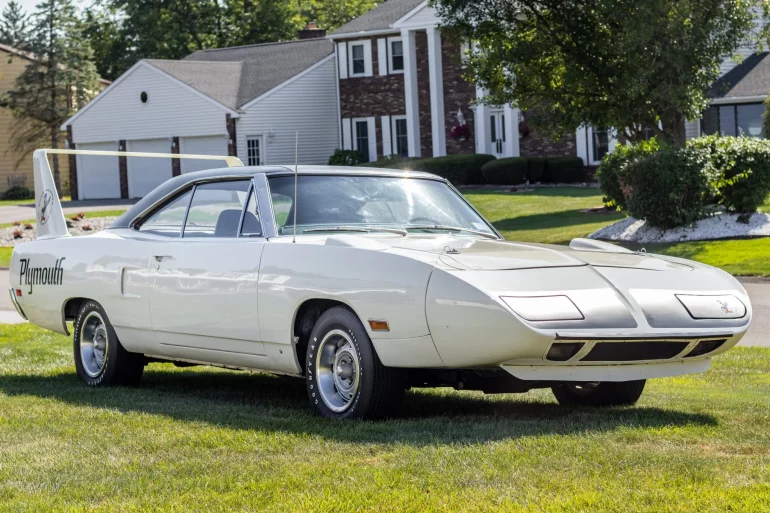
0 - 60: 4.9 seconds / Quarter Mile: 13.5 seconds
Summary
The 1970 Plymouth Superbird is a legendary muscle car known for its outlandish appearance and remarkable performance on the NASCAR circuit. Its distinctive aerodynamic design, featuring a towering rear wing and a pointed nose cone, was a radical departure from traditional automotive styling and was solely aimed at dominating on the high-speed ovals.
Underneath its wild exterior, the Superbird packed a range of powerful V8 engines, with the top-tier option being the legendary 426 Hemi. This behemoth of an engine produced 425 horsepower and 490 lb-ft of torque, propelling the Superbird to a 0-60 mph time of 4.9 seconds. Its aerodynamic shape and raw power allowed it to reach speeds over 200 mph on the track, making it a dominant force in NASCAR racing.
The Superbird's performance wasn't just about straight-line speed. Its aerodynamic design, while primarily focused on reducing drag, also generated significant downforce, improving stability and handling at high speeds. While its road manners weren't as refined as some other muscle cars of the era, the Superbird's track-focused engineering and raw power made it a legend in its own right. Its iconic status was cemented by its association with NASCAR legend Richard Petty, who famously returned to Plymouth after a brief stint with Ford, thanks to the Superbird's competitive edge.
2. 1969 Plymouth Road Runner 426
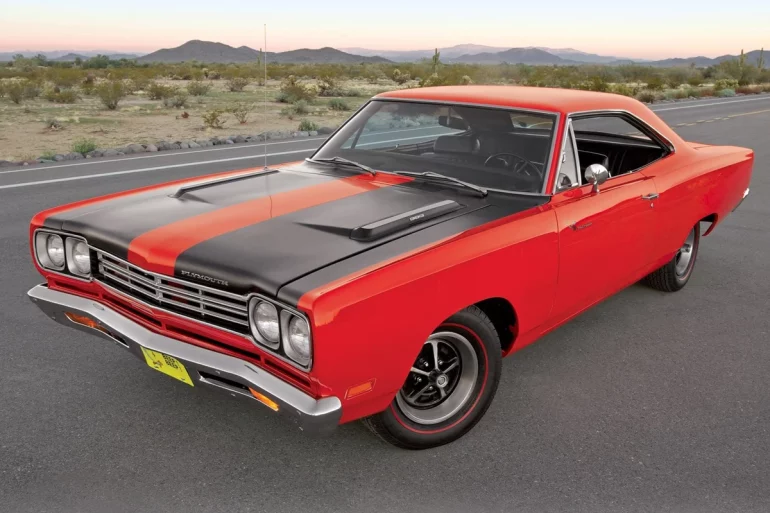
0 - 60: 5.0 seconds / Quarter Mile: 13.5 seconds
Summary
The 1969 Plymouth Road Runner 426 was a force to be reckoned with, a true embodiment of the muscle car era's obsession with power and performance. Under the hood roared the legendary 426 Hemi V8 engine, a monstrous powerplant that churned out an impressive 425 horsepower and 490 lb-ft of torque. This raw power, combined with a lightweight body and a focus on performance, made the Road Runner 426 a dominant force on the drag strip.
With its robust engine and available four-speed manual transmission, the Road Runner 426 could launch from 0 to 60 mph in a mere 5.0 seconds, an impressive feat for its time. It could also conquer the quarter-mile in just 13.5 seconds, leaving many competitors in its dust. The car's simple, no-frills design further emphasized its performance-oriented nature.
While the Road Runner 426 was primarily built for straight-line speed, its suspension and handling were also surprisingly competent. It offered a relatively comfortable ride for a muscle car and could hold its own on twisty roads. The car's distinctive "beep-beep" horn, inspired by the Looney Tunes character, added a playful touch to its otherwise aggressive persona.
The 1969 Plymouth Road Runner 426 remains an iconic muscle car, celebrated for its raw power, legendary engine, and unapologetic attitude. It represents a golden era in American automotive history, when performance ruled the streets and the drag strip.
3. 1969 Plymouth Cuda 440
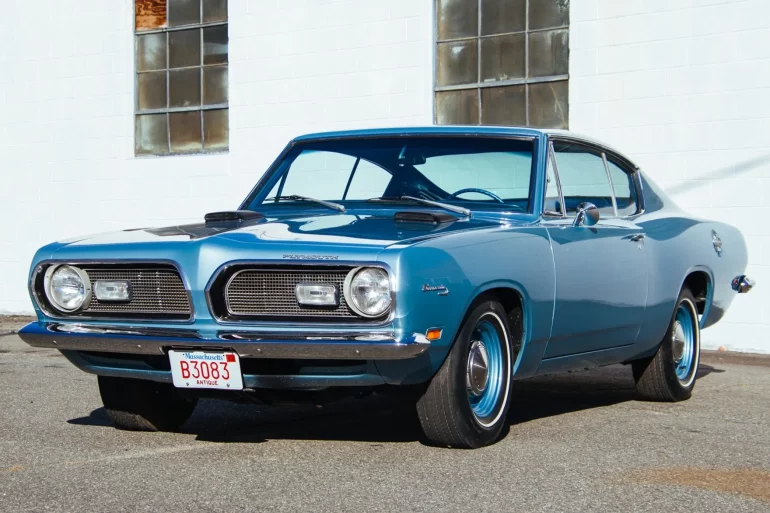
0 - 60: 5.5 seconds / Quarter Mile: 13.8 seconds
Summary
The 1969 Plymouth Cuda 440 was a potent muscle car that packed a serious punch, embodying the raw power and aggression of the era. With its sleek, aerodynamic styling and distinctive "shaker" hood scoop, it exuded an aura of performance that was hard to ignore.
Under the hood, the Cuda 440 housed a massive 440 cubic inch V8 engine, a powerhouse that churned out 375 horsepower and a whopping 480 lb-ft of torque. This engine, available with either a four-speed manual or a three-speed automatic transmission, propelled the Cuda from 0 to 60 mph in around 5.5 seconds, making it a formidable contender on the drag strip. Its quarter-mile time of 13.8 seconds at over 100 mph further solidified its performance credentials.
The Cuda 440's performance wasn't just about straight-line speed. Its heavy-duty suspension, wider tires, and upgraded brakes provided a balanced and responsive driving experience, allowing it to handle corners with surprising agility for a muscle car. Its distinctive exhaust note, a deep, throaty growl that echoed through the streets, added to its allure.
While the 1969 Plymouth Cuda 440 may not have been as iconic as its Hemi-powered counterpart, it was still a force to be reckoned with. It offered a more affordable alternative to the Hemi while still delivering impressive performance and head-turning style. The Cuda 440 remains a highly sought-after classic car, cherished by enthusiasts for its raw power, aggressive styling, and the thrill of driving a true American muscle car.
4. 1970 Plymouth AAR Cuda
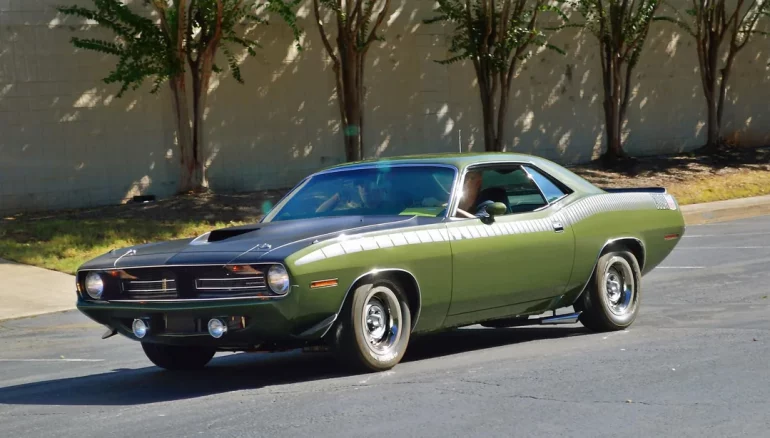
0 - 60: 5.6 seconds / Quarter Mile: 13.9 seconds
Summary
The 1970 Plymouth AAR Cuda was a special edition muscle car built to celebrate the All American Racers (AAR) team and their involvement in the Trans Am racing series. This road-legal homologation special was designed to embody the spirit of the track while offering a thrilling driving experience on the street.
Under the hood, the AAR Cuda packed a unique 340 cubic inch V8 engine equipped with three two-barrel carburetors, known as the "Six Pack" setup. This potent powerplant produced 290 horsepower and 345 lb-ft of torque, propelling the car from 0 to 60 mph in around 5.6 seconds and through the quarter-mile in approximately 13.9 seconds. While not as powerful as the legendary Hemi-powered Cuda, the AAR Cuda's lighter weight and more nimble handling made it a formidable contender on road courses.
The AAR Cuda's performance focus extended beyond its engine. It featured a heavy-duty suspension, wider tires, and upgraded brakes, all designed to improve its handling and responsiveness. Its distinctive side exhaust pipes and unique AAR graphics set it apart from standard Cuda models, making it a head-turner wherever it went. Inside, the AAR Cuda featured a minimalist interior with a focus on functionality, including high-back bucket seats and a pistol-grip shifter.
The 1970 Plymouth AAR Cuda remains a highly sought-after muscle car today, cherished by enthusiasts for its unique styling, impressive performance, and racing heritage. It represents a pivotal moment in Plymouth's history, showcasing the brand's commitment to performance and its ability to create a road-legal version of a successful race car.
5. 1969 Plymouth GTX 440
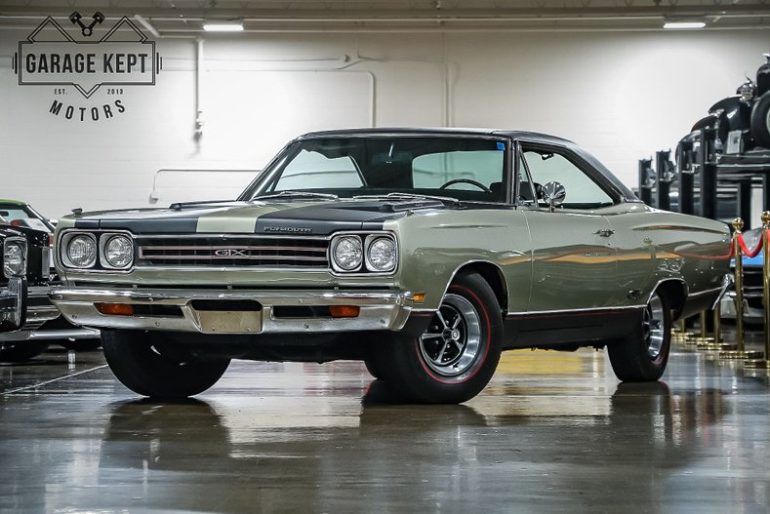
0 - 60: 5.7 seconds / Quarter Mile: 13.5 seconds
Summary
The 1969 Plymouth GTX 440 was a potent muscle car that exuded power and performance. It was a top-tier model in Plymouth's lineup, designed to compete with the best that Detroit had to offer. With its aggressive styling, muscular stance, and impressive performance figures, the GTX 440 was a force to be reckoned with on the street and strip.
Under the hood, the GTX 440 packed a massive 440 cubic inch V8 engine, which was available in various configurations. The standard 440 engine delivered 375 horsepower and 480 lb-ft of torque, providing ample power for exhilarating acceleration and top speed. Optional performance upgrades, such as the "Six Pack" (three two-barrel carburetors) or the "Super Commando Six Pack," could push the power output even higher.
The GTX 440's performance wasn't just about straight-line speed. It also boasted a heavy-duty suspension, wider tires, and upgraded brakes, ensuring it could handle its power and provide a balanced driving experience. While it may not have been as agile as some smaller sports cars, the GTX 440 was surprisingly nimble for its size and could hold its own on winding roads. Its interior was also well-appointed, featuring comfortable seating, stylish gauges, and a variety of options for personalization.


